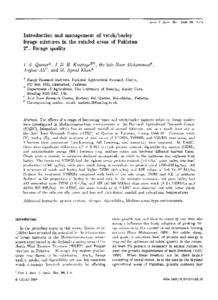| dc.contributor.author | Qamar, I.A. |
| dc.contributor.author | Keatinge, J.D.H. |
| dc.contributor.author | Mohammad, N. |
| dc.contributor.author | Ali, A. |
| dc.contributor.author | Khan, M.A. |
| dc.date.accessioned | 2019-12-04T11:23:35Z |
| dc.date.available | 2019-12-04T11:23:35Z |
| dc.date.issued | 1999 |
| dc.identifier.citation | Qamar, I.A., Keatinge, J.D.H., Mohammad, N., Ali, A. & Khan, M. A. (1999). Introduction and management of vetch/barley forage mixtures in the rainfed areas of Pakistan. 2. Forage quality. Australian Journal of Agricultural Research, 50(1), 11-20. |
| dc.identifier.issn | 0004-9409 |
| dc.identifier.uri | https://hdl.handle.net/20.500.12478/4052 |
| dc.description.abstract | The effects of a range of harvesting times and vetch/barley mixture ratios on forage quality were investigated in Mediterranean-type environments at the National Agricultural Research Centre (NARC), Islamabad, which has an annual rainfall of around 1000 mm, and at a much drier site at the Arid Zone Research Centre (AZRC) at Quetta in Pakistan, during 1994–97. Common vetch (V), barley (B), and their mixtures at seed ratios of V75B25, V50B50, and V25B75 were sown, and 3 harvest time treatments (pre-flowering, full flowering, and maturity) were imposed. At NARC, there were significant differences (P < 0·01) in crude protein content, digestible dry matter (DDM), and metabolisable energy (ME) between crop mixture ratios and between different harvest times. Crude protein content in mixtures declined substantially as vetch in the mixtures was replaced with barley. The treatment V75B25 had the highest crude protein content (>1 t/ha), pure barley was least productive (<300 kg/ha), with pure vetch being intermediate in protein yield (700–800 kg/ha). All 3 mixtures of vetch and barley had higher DDM (4-5 t/ha) and ME values of 5–6·5 104 MJ/ha (highest for treatment V75B25) compared with both of the sole crops. DDM and ME in mixtures declined as the proportion of barley in the seed ratio in the mixtures increased, but pure barley had still somewhat more DDM (3·6 t/ha) and ME (43 344 MJ/ha) than pure vetch (3·2 t DDM/ha and 42 035 MJ ME/ha). At AZRC, the same trends as at NARC were observed but with lower yields because of the substantially lower and less well distributed rainfall and suboptimal temperatures. |
| dc.language.iso | en |
| dc.subject | Protein Content |
| dc.subject | Nitrogen |
| dc.subject | Digestibility |
| dc.subject | Mediterranean Climate |
| dc.subject | Environment |
| dc.subject | Dryland Farming |
| dc.title | Introduction and management of vetch/barley forage mixtures in the rainfed areas of Pakistan 2. Forage quality |
| dc.type | Journal Article |
| dc.description.version | Peer Review |
| cg.contributor.affiliation | National Agricultural Research Centre, Pakistan |
| cg.contributor.affiliation | University of Reading |
| cg.contributor.affiliation | Arid Zone Research Centre, Pakistan |
| cg.contributor.affiliation | International Institute of Tropical Agriculture |
| cg.coverage.region | Asia |
| cg.coverage.region | South Asia |
| cg.coverage.country | Pakistan |
| cg.coverage.country | Australia |
| cg.isijournal | ISI Journal |
| cg.authorship.types | CGIAR and developing country institute |
| cg.iitasubject | Climate Change |
| cg.iitasubject | Farm Management |
| cg.iitasubject | Crop Systems |
| cg.iitasubject | Farming Systems |
| cg.accessibilitystatus | Limited Access |
| local.dspaceid | 99338 |

